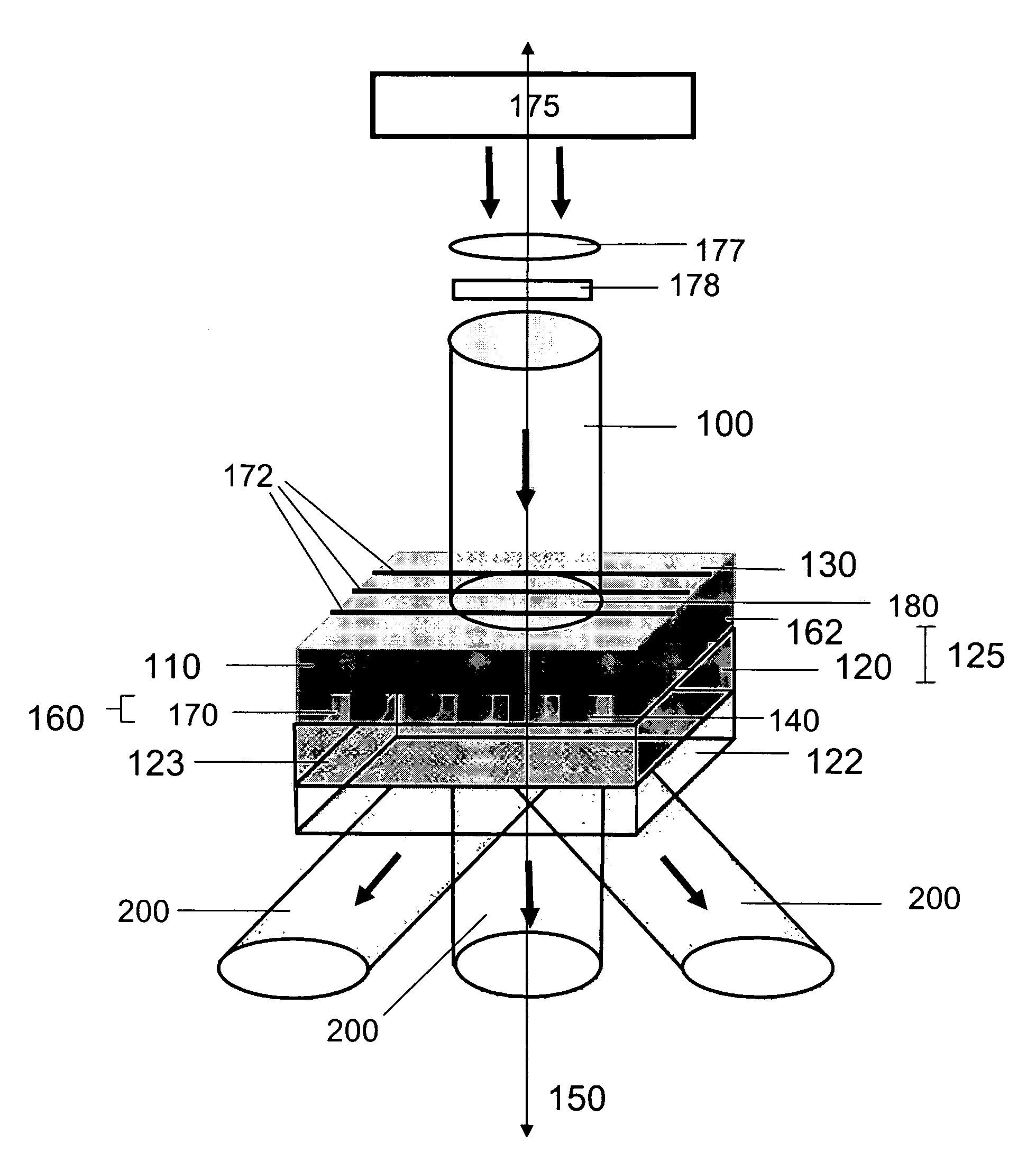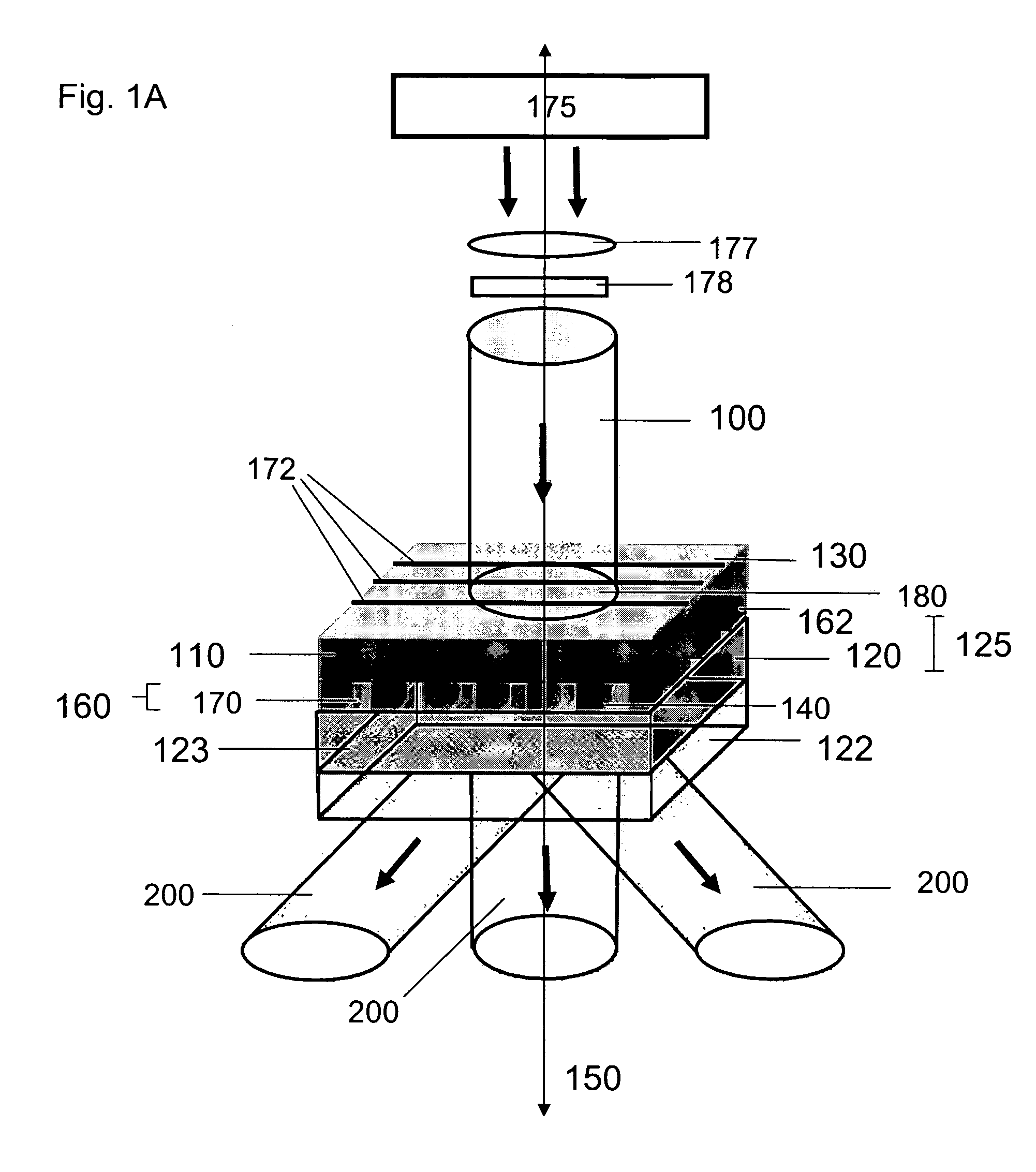Methods and devices for fabricating three-dimensional nanoscale structures
a three-dimensional nanoscale and nano-scale technology, applied in the direction of photo-taking processes, printers, instruments, etc., can solve the problem of generating an optical interference pattern within radiation sensitive materials, and achieve the effect of simple optical arrangemen
- Summary
- Abstract
- Description
- Claims
- Application Information
AI Technical Summary
Benefits of technology
Problems solved by technology
Method used
Image
Examples
example 1
Fabrication of a Nanoporous Filter Integrated into a Microfluidic Channel
[0102]The practical utility of 3D nanostructures depends critically on their mechanical robustness and the ability to integrate them within microsystems, nanosystems and / or larger scale components to produce functional devices. To evaluate the utility of nanostructures generated by the present methods and devices, a nanoporous filter was fabricated and integrated within a microfluidic channel in a microfluidic system. The ability of the methods and devices of the present invention to fabricate useful 3D nanostructures was verified by demonstrating good mechanical properties and filtering performance of the nanoporous filter constructed.
[0103]To illustrate these features, a 3D nanostructured filter element was fabricated comprising a plurality of 3D nanostructures and integrated into a channel of a microfluidic system for separating sub-micron particles from fluid flows. The conformable phase mask employed in th...
example 2
Modeling calculations of the Intensity Distributions and Nanostructures Generated by Phase Masks of the Present Invention
[0108]FIG. 7A-L present scanning electron micrographs and modeling results (see inserts) for a broad range of periodic structures that can be fabricated over large areas using the methods of the present invention. These methods are high versatile and may be used with a variety of phase mask types, optical configurations and light sources, such as visible and ultraviolet lasers as well as filtered mercury lamps. Rigorous coupled wave analysis defines the computed distributions of intensity in each case, as illustrated in the insets, except for frames 7H, 7I and 7J, which were determined using Fraunhofer analysis to avoid the excessive computational requirements of Rigorous coupled wave analysis for these cases. A quantitative analysis of the modeling results and scanning electron micrographs indicates good agreement between computed distributions of intensity and t...
example 3
Selective Variation of Spatial and Temporal Coherence of Electromagnetic Radiation Used in the Present Methods
[0117]In embodiments of the present invention useful for a number of fabrication applications, the spatial coherence and / or temporal coherence of the electromagnetic radiation used in the present methods is selectively adjusted to control important structural characteristics of 3D structures fabricated, such as the region of a 3D structure in which nanoscale and / or microscale features are localized. Control provided by selective variation of spatial and / or temporal coherence is used in these methods of the present invention to optimize selected structural characteristics for a diverse range of applications, device configurations and device environments.
[0118]In one embodiment, the temporal coherence and / or spatial coherence of electromagnetic radiation directed onto a mask element in optical communication with a radiation sensitive material is selected to prepare 3D structur...
PUM
| Property | Measurement | Unit |
|---|---|---|
| heights | aaaaa | aaaaa |
| thicknesses | aaaaa | aaaaa |
| thickness | aaaaa | aaaaa |
Abstract
Description
Claims
Application Information
 Login to View More
Login to View More - R&D
- Intellectual Property
- Life Sciences
- Materials
- Tech Scout
- Unparalleled Data Quality
- Higher Quality Content
- 60% Fewer Hallucinations
Browse by: Latest US Patents, China's latest patents, Technical Efficacy Thesaurus, Application Domain, Technology Topic, Popular Technical Reports.
© 2025 PatSnap. All rights reserved.Legal|Privacy policy|Modern Slavery Act Transparency Statement|Sitemap|About US| Contact US: help@patsnap.com



